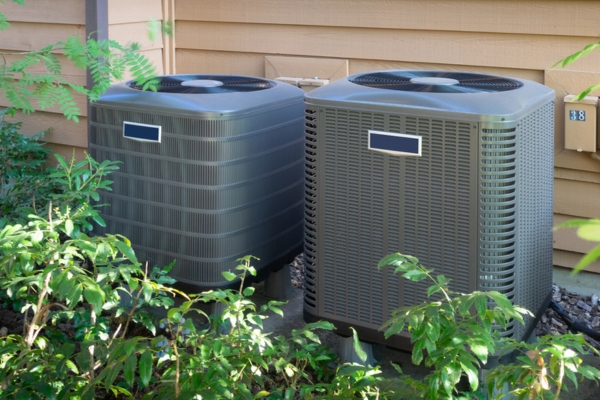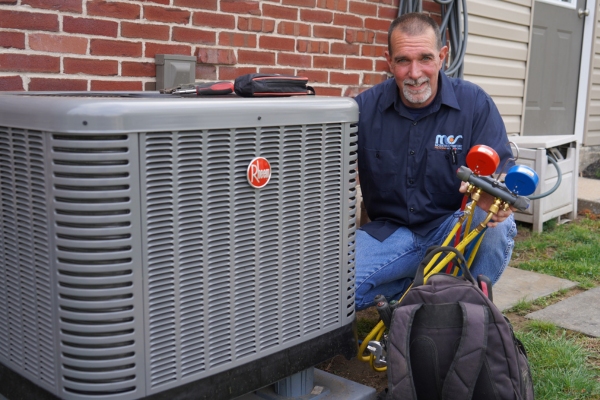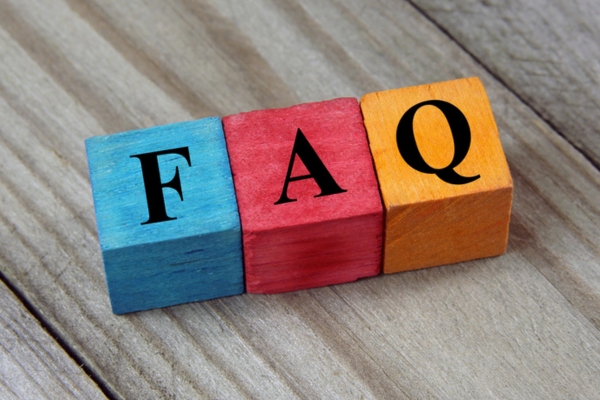If you’re in the market for a new HVAC system, either as a novice purchaser or someone seeking to upgrade, selecting the appropriate type is essential. Choosing between central vs forced air systems dramatically affects your home’s comfort level and energy usage. This detailed article from Modern Comfort will explore the differences between these commonly preferred systems to help you make an informed choice that meets your home’s needs.
Delving into the intricate language of HVAC can be overwhelming. At Modern Comfort, celebrated for our deep expertise and extensive experience, we strive to simplify this journey. We are dedicated to providing you with all the essential information needed to make a knowledgeable choice regarding your HVAC system. With our team, you can be assured that selecting us is the best choice for your heating and cooling requirements.
Understanding Forced Air Systems: Overview and Operations

“Forced air” frequently refers to HVAC systems that circulate warm air throughout a home using a series of ducts and vents, a term often employed by industry professionals. Yet, this explanation only provides a basic understanding. A forced-air system includes any HVAC configuration that drives temperature-regulated air into occupied areas. Usually, when HVAC experts talk about forced air, they mean systems that incorporate furnaces or heat pumps.
Ensure year-round comfort in your home with expert HVAC installation and maintenance from Modern Comfort. Schedule your service today!
How Furnaces Work
Whether they utilize gas, oil, or electricity, furnaces function based on the same fundamental principles to heat your home, here’s the process:
- Heat Generation: The process starts with the furnace generating heat. Either through burning propane, oil, natural gas, or by converting electricity.
- Heat Transfer: The produced heat is then moved to a heat exchanger, which heats up as the furnace runs.
- Air Heating: As air from your home moves through the ductwork, it flows over the heated heat exchanger, where it picks up warmth.
- Air Distribution: A blower in the furnace propels this heated air through the ducts, ensuring even heating throughout different rooms.
These systems are called forced-air furnaces because they use blowers to distribute the heated air.
Explaining Heat Pumps Operations
A heat pump is a multifunctional device that heats and cools your home. It functions similarly to an air conditioner but with one significant difference. It can reverse its functionality depending on the season.
Here’s how it effectively manages indoor temperatures all year long:
- Heat Extraction and Transfer: In the cooler months, the heat pump pulls heat from external sources—air, ground, or water—via an evaporator coil. This captured warmth is then conveyed to a heat exchanger inside the system.
- Evaporation: When ambient heat meets the refrigerant in the heat pump, the refrigerant evaporates, transitioning from liquid to vapor, efficiently absorbing heat.
- Compression: Once the refrigerant has evaporated, the heat pump’s compressor compresses the vapor, substantially raising its temperature.
- Condensation: The heated vapor then enters the condenser, which cools down and returns to its liquid state. Here, the condenser serves as an additional heat exchanger, transferring the heat to water in the central heating system.
- Heat Distribution: The system then distributes this heat throughout your home. Depending on the type of heat pump, this distribution may occur through underfloor piping, radiators, or forced air using ductwork and motorized blowers.
Central Air Conditioning: Effective Cooling Explained
Central air conditioning systems offer a reliable and efficient method to cool your home via a closed loop of refrigerated air. Here’s how central air functions to maintain a comfortable indoor temperature:
- Air Intake: Warm air inside your home is pulled into the system via a vent, which moves over the evaporator coils.
- Heat Absorption: These coils, containing refrigerant, draw heat out of the air, effectively cooling it. This cooled air is then distributed back throughout the house through ductwork.
- Compression: Once the refrigerant absorbs heat and converts it into gas, it flows to the compressor. The refrigerant’s volume is decreased in the compressor, increasing its temperature and pressure.
- Heat Release: The high-pressure gas then travels to the condenser in the outdoor unit. There, it releases the absorbed heat into the outside air. As it releases heat, the refrigerant cools and transitions back to liquid.
- Recirculation: This cooled liquid refrigerant is recirculated to the evaporator coils to start the cooling cycle anew.
Don’t wait for your HVAC system to fail. Contact Modern Comfort for reliable maintenance and repairs to keep your home comfortable all year round.
Distinguishing Central Air from Forced Air Systems

The main difference between central vs forced air systems is their designated functions. Central air systems are solely focused on cooling. They employ a system of ducts, vents, and a plenum—a central chamber responsible for dispersing cooled air—to manage temperature across your home.
Conversely, a forced air system can describe any HVAC system that utilizes a blower to move air through a home’s ductwork. This includes heating and cooling systems, like furnaces and central air conditioners. While central air systems are dedicated exclusively to cooling, forced air systems are versatile, offering heating and cooling capabilities depending on their configuration.
Despite these differences in functionality, both types of systems often employ the same ductwork for air distribution, which can cause some confusion. Due to their similar infrastructure and the commonality of using ducts to transport temperature-controlled air, HVAC professionals sometimes use the terms interchangeably.
Upgrade your HVAC system with Modern Comfort and experience top-tier efficiency and comfort. Get a free, in-home estimate now!
Selecting the Right HVAC System: Forced-Air vs. Central Air

In deciding on the best HVAC system for your home, evaluate your existing infrastructure and particular climate control requirements. A forced-air system provides heating and cooling solutions and superior air filtration capabilities, making it excellent for enhancing indoor air quality and effectively controlling humidity. These systems are energy-efficient, demand low maintenance, and can contribute to lowering your monthly energy expenses.
On the other hand, a central air system is dedicated solely to cooling and is a good choice if your home is already equipped with ductwork. Modern central air units are notably efficient and excel at maintaining a stable, comfortable temperature, particularly in humid environments.
Whatever system you choose, have it installed and maintained by a professional HVAC technician to ensure optimal performance and efficiency. This could potentially result in substantial savings on your utility bills. The decision between forced air and central air typically depends on whether you require a comprehensive solution for heating and cooling or a specialized system solely for cooling.
Central vs. Forced Air FAQs

Here are common queries regarding central vs forced air systems:
What Should I Consider When Selecting Between Forced Air and Central Air Systems?
When choosing between forced air and central air systems, consider your home’s needs, existing infrastructure, and the local climate. Consider your home’s size, your goals for energy efficiency, and whether you need a system that handles heating and cooling or just cooling. Additionally, seeking advice from HVAC professionals can offer specialized insights suited to your requirements.
How Can I Ensure Optimal Efficiency and Performance From My Chosen HVAC System?
Consistent maintenance is essential for ensuring your HVAC system works optimally and efficiently. Arrange for professional inspections and tune-ups to identify and rectify any issues promptly. Enhancing your home’s insulation, ensuring ductwork is well-sealed, and opting for energy-efficient equipment can significantly reduce energy use and decrease utility expenses over time.
What Role Does Professional Installation Play in the Effectiveness of an HVAC System?
Professional installation is critical for correctly sizing, positioning, and integrating your HVAC system, ensuring it operates effectively in your home. Qualified HVAC technicians can evaluate your needs, suggest the best equipment, and install it properly to maximize performance and efficiency. Moreover, professional installation usually includes warranties and guarantees, offering additional security and ongoing support for your investment.
Conclusion
HVAC systems are vital in creating a comfortable and welcoming home environment for daily life and entertaining guests. Your specific environmental requirements and personal preferences should guide the choice between forced-air and central-air systems.
Evaluate the distinct characteristics of your living space and consider the advantages of each system’s features. Whether you opt for the adaptability of a forced-air system that provides both heating and cooling or the focused efficiency of a central air system for cooling alone, selecting the right system is crucial for maintaining a pleasant atmosphere all year round.
Call Modern Comfort for All Your HVAC Needs
Modern Comfort provides top-tier heating and cooling services across Central Maryland, and Southern and Central Pennsylvania. Our highly qualified technicians are professionally certified to offer exceptional HVAC tune-ups, repairs, installations, and replacements. All our technicians are equipped with the expertise to ensure your home’s HVAC system functions flawlessly.
At Modern Comfort, we proudly offer competitive rates for reliable heating and cooling services in the region. Our home comfort maintenance services are designed to enhance your comfort, boost your energy efficiency, and minimize your heating and cooling expenses. Should you require HVAC repair or need a replacement system, we’re ready to recommend the most suitable options that fit your budget. We stand behind every job with a solid satisfaction guarantee. To set up a service appointment or receive a free, in-home estimate, call Modern Comfort today.
You can click here to contact us now or call us at (410) 429-7252 (MD residents) and (717) 489-3939 (PA residents) to find out more! Click the link to view our service area.
If you’re located in Westminster, MD, investing in a new system to improve your HVAC in Westminster home comfort, contact Modern Comfort, your reputable Heating and Cooling Contractor, to learn more about the benefits of a new HVAC system in Westminster! We also service the following Maryland areas: Manchester, Hampstead, Finksburg, Reistertown, New Windsor, Union Bridge, Taneytown, Frizzellburg, Alto Vista, Carrollton, and all surrounding areas.

Related Articles:
- Selecting Wisely: Criteria For Choosing An Air Conditioner Replacement Company
- Keep Your Air Conditioning System Healthy By Avoiding These 7 Mistakes
- Cooling Crisis: AC Compressor Working But Not Cooling
- Troubleshooting & Fixing HVAC Ductwork Noise
- Breathe Easy: Best Ways To Prevent Air Conditioner Mold

Recent Articles
